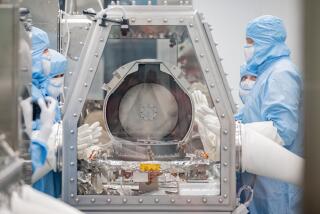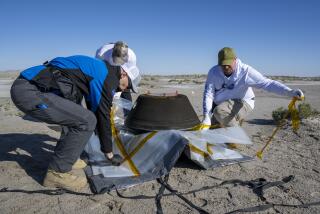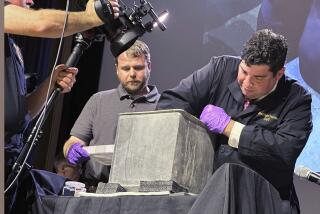Science Success in Space Meets Earthly Disaster
- Share via
A sensitive protein crystal experiment that was rocketed into orbit aboard the space shuttle Discovery came to an unfortunate crash landing at the Birmingham, Ala., Municipal Airport, rendering the experiment worthless, it was learned Saturday.
The crash landing--one day after Discovery’s March 18 landing at Edwards Air Force Base--did not occur on the Tarmac. Rather, it happened in Birmingham Airport’s Concourse C, as it passed through the conveyor belt of the X-ray security machine. The problem was, it tipped over, perhaps with the help of a bungling security guard.
“That’s the way it goes in science. Experiments fail for a lot of reasons, but this is a new one on us,” said UC Riverside biochemistry professor Alexander Mc Pherson. “I’m not real happy.”
Mc Pherson now is hoping to book the experiment on a future shuttle mission. The goal is to learn more about how protein crystals grow in a weightless environment--an endeavor that may someday enable scientists to design new cancer-fighting medicines, Mc Pherson said. The experiment--one of several he has placed on shuttle flights--was among 60 crystal experiments that rode Discovery on its five-day mission last month.
After 79 orbits and a perfect landing, everything seemed fine. Unloaded from Discovery, Mc Pherson’s experiment was transported in its shuttle case to the University of Alabama at Birmingham, where the protein crystals were carefully unpacked and placed in glass plates. Those plates were then packed inside a Styrofoam ice chest.
Delicate Assignment
Mc Pherson’s aide on the experiment, postdoctoral fellow Stan Koszelak, was dispatched to Birmingham to carry the box back to UC Riverside. The instruction: Keep the box upright.
But Koszelak couldn’t hand carry it through the X-ray machine. X-rays themselves were not the concern. According to Mc Pherson, Koszelak warned security guards about the importance of keeping the box upright before placing it on the machine’s conveyor belt.
“As it was coming out the other end,” Mc Pherson said, “it started to tip over . . . Stan let loose a scream.”
A well-meaning security guard, Mc Pherson said, ran to the box, apparently planning to right it. Instead, he completely upended the experiment.
Koszelak’s reaction attracted police and a jetliner pilot, who happened to be passing by. “They all thought Stan was some sort of troublemaker,” Mc Pherson said.
Princella King, a security worker at Birmingham Airport, recalled the incidents of March 19. Contacted by telephone at her work, King said she was manning the Concourse C X-ray machine that night and vaguely remembered “the guy who said he was an astronaut or a scientist or something.”
Source of Trouble
King said the box may have gotten caught on the rubber flaps that hang at the exit of the machine.
“It wasn’t no big thing,” King said. “He just picked it up and left. There isn’t going to be any trouble, is there?”
Actually, the Federal Aviation Adminstration is looking into the matter, Mc Pherson said. On March 22, Mc Pherson said he told NASA officials and other crystal researchers of his troubles at a meeting in Monterey.
“They were dismayed to say the least, “ he said. “NASA has stickers we could have put on the container that would have allowed us to carry it straight through without security examination. Someone never thought to do that. NASA is a monstrous agency and nobody knows what’s what.”
Mc Pherson figures $5 worth of equipment was lost. Of course, he added, that does not include the thousands of dollars spent in years of research, or the “$1,200 to fly Stan to Birmingham.”







